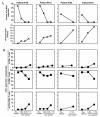Severe CD4+ T-cell depletion in gut lymphoid tissue during primary human immunodeficiency virus type 1 infection and substantial delay in restoration following highly active antiretroviral therapy
- PMID: 14557656
- PMCID: PMC229357
- DOI: 10.1128/jvi.77.21.11708-11717.2003
Severe CD4+ T-cell depletion in gut lymphoid tissue during primary human immunodeficiency virus type 1 infection and substantial delay in restoration following highly active antiretroviral therapy
Abstract
Gut-associated lymphoid tissue (GALT) harbors the majority of T lymphocytes in the body and is an important target for human immunodeficiency virus type 1 (HIV-1). We analyzed longitudinal jejunal biopsy samples from HIV-1-infected patients, during both primary and chronic stages of HIV-1 infection, prior to and following the initiation of highly active antiretroviral therapy (HAART) to determine the onset of CD4(+) T-cell depletion and the effect of HAART on the restoration of CD4(+) T cells in GALT. Severe depletion of intestinal CD4(+) T cells occurred during primary HIV-1 infection. Our results showed that the restoration of intestinal CD4(+) T cells following HAART in chronically HIV-1-infected patients was substantially delayed and incomplete. In contrast, initiation of HAART during early stages of infection resulted in near-complete restoration of intestinal CD4(+) T cells, despite the delay in comparison to peripheral blood CD4(+) T-cell recovery. DNA microarray analysis of gene expression profiles and flow-cytometric analysis of lymphocyte homing and cell proliferation markers demonstrated that cell trafficking to GALT and not local proliferation contributed to CD4(+) T-cell restoration. Evaluation of jejunal biopsy samples from long-term HIV-1-infected nonprogressors showed maintenance of normal CD4(+) T-cell levels in both GALT and peripheral blood. Our results demonstrate that near-complete restoration of mucosal immune system can be achieved by initiating HAART early in HIV-1 infection. Monitoring of the restoration and/or maintenance of CD4(+) T cells in GALT provides a more accurate assessment of the efficacy of antiviral host immune responses as well as HAART.
Figures







References
-
- Ameisen, J. C., and A. Capron. 1991. Cell dysfunction and depletion in AIDS: the programmed cell death hypothesis. Immunol. Today 12:102-105. - PubMed
-
- Andersson, J., T. E. Fehniger, B. K. Patterson, J. Pottage, M. Agnoli, P. Jones, H. Behbahani, and A. Landay. 1998. Early reduction of immune activation in lymphoid tissue following highly active HIV therapy. AIDS 12:F123-F129. - PubMed
-
- Autran, B., G. Carcelain, T. S. Li, C. Blanc, D. Mathez, R. Tubiana, C. Katlama, P. Debre, and J. Leibowitch. 1997. Positive effects of combined antiretroviral therapy on CD4+ T cell homeostasis and function in advanced HIV disease. Science 277:112-116. - PubMed
-
- Brandtzaeg, P. 1989. Overview of the mucosal immune system. Curr. Top. Microbiol. Immunol. 146:13-25. - PubMed
-
- Haase, A. T. 1999. Population biology of HIV-1 infection: viral and CD4+ T cell demographics and dynamics in lymphatic tissues. Annu. Rev. Immunol. 17:625-656. - PubMed
Publication types
MeSH terms
Grants and funding
LinkOut - more resources
Full Text Sources
Other Literature Sources
Medical
Research Materials

